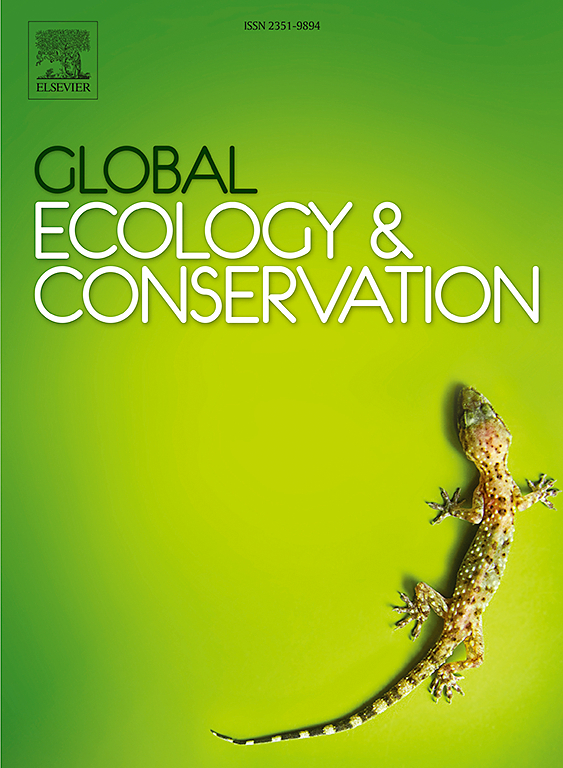15年来易受干扰景观中等柏属林地的时空动态
IF 3.5
2区 环境科学与生态学
Q1 BIODIVERSITY CONSERVATION
引用次数: 0
摘要
了解生产力和干扰对植被演替的影响是群落生态学中的一个重要争论,对生物多样性保护具有重要意义。生产力和干扰影响物种丰富度和结构,增强了我们对植被动态和物种共存的认识。许多理论,如中间应力假说、中间扰动假说和动态平衡模型,已经被提出来解释这些机制。然而,我们对生产力和干扰如何影响等柏属林地时空动态的理解仍然有限。我们分析了15年(2006-2020)南北向降水梯度(1112-991 mm /年)16个站点64个永久样地(每个400 m²)的植物区系数据。我们计算了小树和成树的物种丰富度和密度,并估计了两个主要变量:以水分亏缺为代表的潜在生产力和以伐木率为代表的干扰强度。采用线性混合效应模型,以样地嵌套为随机变量,研究了潜在生产力和干扰水平对幼树和成树物种丰富度和密度的影响。结果表明,无论受干扰程度和潜在生产力梯度的影响,幼树和成树的物种丰富度和密度都随时间的推移而降低。与高干扰水平相比,低干扰和中等干扰水平显著增加了幼树和成树的物种丰富度。成树和幼树密度随时间的变化呈下降趋势,但随干扰程度由高到低而增加。这些结果表明,增加的干扰减少了林地物种的密度,有利于入侵物种,特别是稀树草原物种。总体而言,我们的结果与动态平衡模型一致,突出了生态系统中干扰制度、生产力梯度及其对物种丰富度的影响之间的复杂相互作用。在以异柏属植物为主的森林中,有效的森林管理将避免促进入侵物种建立的高水平采伐,并将长期保持该生态系统的生物多样性。本文章由计算机程序翻译,如有差异,请以英文原文为准。
Spatio-temporal dynamics of Isoberlinia-dominated woodlands in disturbance-prone landscapes over 15 years
Understanding the impact of productivity and disturbance on vegetation succession is a crucial debate in community ecology, with significant implications for biodiversity conservation. Productivity and disturbance influence species richness and structure, enhancing our understanding of vegetation dynamics and species coexistence over time. Numerous theories, such as the Intermediate Stress Hypothesis, Intermediate Disturbance Hypothesis, and Dynamic Equilibrium Model, have been proposed to explain these mechanisms. However, our understanding of how productivity and disturbance affect the spatio-temporal dynamics of Isoberlinia-dominated woodlands remains limited. We analyzed floristic data from sixteen sites with 64 permanent plots (400 m² each) along a south-north precipitation gradient (1112–991 mm per year) over 15 years (2006–2020). We calculated species richness and density for sapling and adult trees, and estimated two main variables: potential productivity using water deficit as a proxy, and disturbance intensity using logging rate. A linear mixed effects model, with plots nested within sites as random variables, was developed to test the effect of potential productivity and level of disturbance on species richness and density, for sapling and adult trees. Our results showed that species richness (SR) and density, for saplings and adult trees decreased over time, regardless of the disturbance and potential productivity gradients. Compared to higher levels of disturbance, low and medium levels of disturbance significantly increase the species richness of saplings and adult trees. In addition, the density of adult trees and saplings decreased over time, but increased with the level of disturbance from high to low. These results suggest that increased disturbance reduces the density of woodland species in favor of invasive species, typically savanna species. Overall, our results are consistent with the Dynamic Equilibrium Model, highlighting the complex interactions between disturbance regimes, productivity gradients, and their effects on species richness within ecosystems. Efficient forest management in Isoberlinia-dominated would avoid the high levels of logging that promote the establishment of invasive species and would maintain the biodiversity of this ecosystem in the long term.
求助全文
通过发布文献求助,成功后即可免费获取论文全文。
去求助
来源期刊

Global Ecology and Conservation
Agricultural and Biological Sciences-Ecology, Evolution, Behavior and Systematics
CiteScore
8.10
自引率
5.00%
发文量
346
审稿时长
83 days
期刊介绍:
Global Ecology and Conservation is a peer-reviewed, open-access journal covering all sub-disciplines of ecological and conservation science: from theory to practice, from molecules to ecosystems, from regional to global. The fields covered include: organismal, population, community, and ecosystem ecology; physiological, evolutionary, and behavioral ecology; and conservation science.
 求助内容:
求助内容: 应助结果提醒方式:
应助结果提醒方式:


